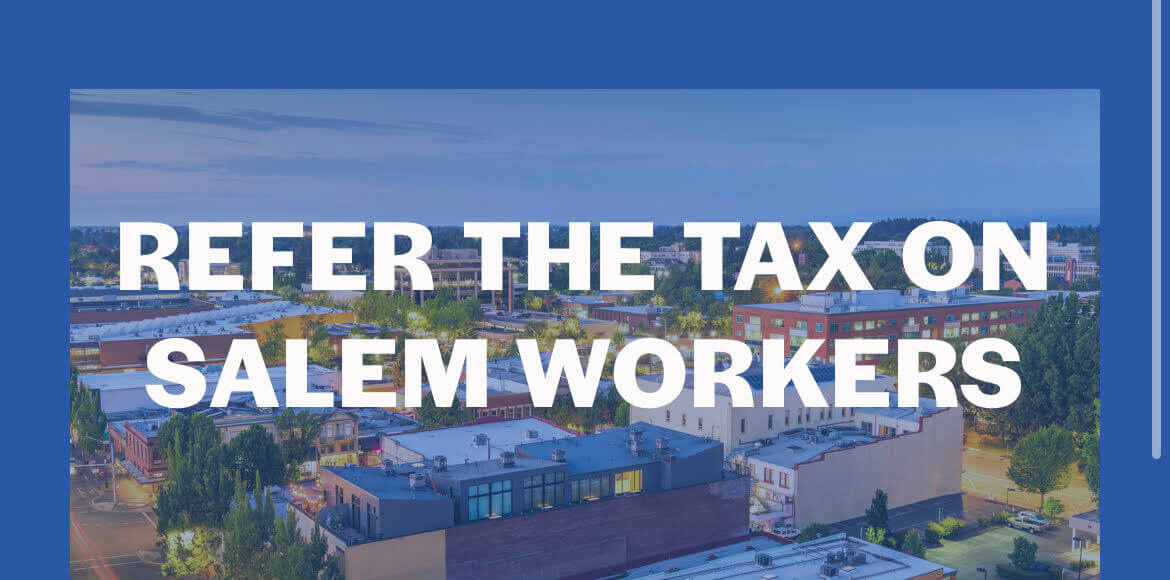Let Salem Vote!: Will citizens decide on the employee-paid payroll tax in November?

Salem, Ore. –The Oregon Business & Industry has gathered over 5,000 unverified signatures for the “Let Salem Vote!” petition as of July 30, seeking to put the newly adopted Safe Salem employee-paid payroll tax Ordinance on the November ballot. If the petition is successful, voters would have the chance to reject the nearly 1% payroll tax scheduled to start in the summer of 2024, which would cost the average Salem resident earning $62,192 annually, over $500 each year.
The City Council passed the Safe Salem tax with a 5-4 vote during the July 10 meeting. It aims to generate $27.9 million in annual revenue to address the existing $19.4 million General Fund deficit. This revenue will support crucial maintenance and improvement of emergency services constrained by property tax limitations.
Why let Salem voters decide?
Angela Wilhelms, President and CEO of Oregon Business & Industry, said that OBI filed the petition in response to strong public opposition during the July 10 Council meeting, driven by voter concerns about the proposal’s vagueness, high tax rate, administrative burden, and uncertainty regarding fund allocation.
“The referendum process has always been in place, and many people just don’t know about it,” she said. “The law gives citizens in Oregon the right to refer some things to the ballot, but the rules and turnaround time are tight.”
OBI must submit the required paperwork by August 9, including 4,000 verified signatures from registered voters within city limits. They’ve established the website www.letsalemvote.com to address common questions about the petition.
Wilhelms said the “Let Salem Vote!” campaign has received substantial positive feedback from the public, including numerous situations shared by employees who anticipate compliance challenges due to being on the road, working at different job sites, following hybrid schedules, or engaging in remote work.
“We’ve heard from employers and employees outside of Salem who work part-time or occasionally in the city and are confused about this tax and its applicability but don’t have the right to vote,” said Wilhelms. “We’ve also heard from people in Salem who are confused about the tax applicability, the tracking systems, and lack a clear understanding of how the money will be distributed.”
Wilhelms said the City should better define Ordinance ambiguities before hastily enacting a critical tax policy.
“How much of an administrative burden will this place on employees and employers to do those tracking calculations every pay period? How is the money going to be spent? Community safety was broadly defined, for example,” she said. “This will be a lot of administrative work for the City. How much of the revenue will be paid to administer the tax? These are some of the ambiguities.”
Can Salem afford to reject this employee-paid payroll tax?
One debate surrounding the employee-paid payroll tax is whether Salem can afford the additional time and expenses for putting the tax on the November ballot. These include special election expenses, educational campaign costs, and the possibility of needing to revisit the drawing board if the Ordinance is rejected, prolonging the impact of the $19.4 million shortfall on emergency services.
In the July 10 Council meeting, Mayor Chris Hoy said Salem has grown by 26,000 residents since 2008. But Oregon property tax limitations have kept emergency services staffing budgets unchanged for the past 15 years.
“We’ve been cutting and cutting, and we can’t cut anymore,” Hoy said. “We have been kicking this can down the road and can’t kick it any further. We have to deal with it.”
City Councilor Trevor Phillips, an emergency room physician, expressed concerns before the July 10 vote about the consequences of delaying the tax implementation and continuing emergency services with a deficit.
“The understaffing across all departments is profound. Any additional cuts will be bone,” said Phillips. “We are cutting critical services, which I find deeply concerning as an emergency room doctor.”
Phillips said the Safe Salem tax is an investment that would meet critical needs now because police and fire capabilities have pulled back to just doing 911 responses, basic patrolling, and major crimes. He said the tax would provide the means to implement community-led policing, hire at least ten additional police officers, allocate funds to support the Navigation Center for the homeless, establish a second fire station, appoint two park rangers, and hire additional long-term city planners.
City Councilor Linda Nishioka said she wants voters to recognize the importance of actively paying attention to what the city government is doing to help keep the city in service and understand the reasonings behind the deficit and why we need help.
“Salem faces the unique challenges of being the state capital and not getting any revenue from all of the state buildings, having 70,000 workers that come into the city that don’t contribute to the public services that they either use or could potentially use – like police or fire, and that voters need to remember that Salem has limited property taxes due to Measures 5 and 50 that have capped all cities in Oregon since the 90s,” Nishioka said. “We have to be educating everybody. Education is one of the most critical aspects of the Ordinance.”
What’s next in the petition process?
Nishioka said that if the petition passes and the Ordinance reaches the November ballot, Salem will face the challenge of whether or not to create an official educational campaign to keep the public informed about the significance of voting “yes,” providing accurate information about the Ordinance and reasons to support it.
“I will continue to support it through my mechanisms like the Neighborhood Associations, small groups, sending emails, and explaining the things we will lose without the Ordinance,” she said. “But it’s also very costly to have a citywide campaign. It could cost $70,000 to $100,000 to produce TV advertisements, flyers, and a website. It’s a lot of decisions that we would have to make in a short time.”
Nishioka emphasized that timing is everything right now. “There’s so much riding on the next few weeks,” she said. “There are many uncertainties as we wait for the results of the petition and discuss as a Council what the best options are going forward.”
Wilhelms and OBI agree that the community’s urgent issues require prompt attention and solutions. “For us, it’s not about slowing down. But urgency cannot excuse a poorly written policy, which is the crux of what we’re saying,” she said. “On July 10, several requests were made that this vote not be taken by the Council but be referred to the voters. And a Council majority declined.”
“Wilhelms and OBI believe that the people of Salem deserve their chance to have their voices represented on the ballot. “Hopefully, we can see that come to fruition,” she said. “I guess we’ll know in a few weeks.”






